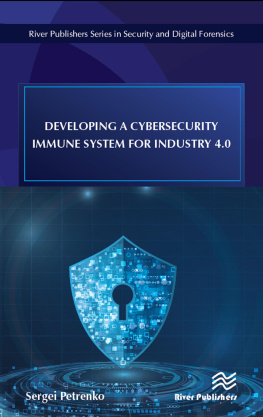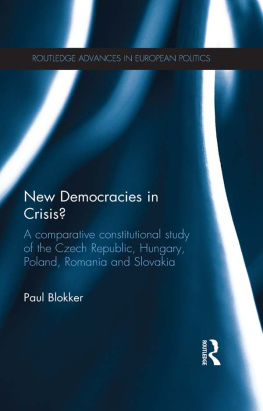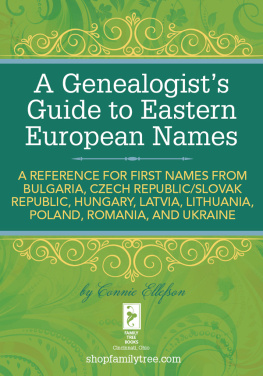CENTRAL EUROPEAN INDUSTRY IN THE INFORMATION AGE
Central European Industry in the Information Age
Hans Van Zon
University of Sunderland
Brian Dillon
Nexus Europe
Jerzy Hausner
Cracow University of Economics
Dorota Kwiecinska
Cracow University of Economics
First published 2000 by Ashgate Publishing
Reissued 2019 by Routledge
2 Park Square, Milton Park, Abingdon, Oxon, OX14 4RN
52 Vanderbilt Avenue, New York, NY 10017
Routledge is an imprint of the Taylor & Francis Group, an informa business
Copyright 2000, Hans van Zon, Brian Dillon, Jerzy Hausner and Dorota Kwiecinska
All rights reserved. No part of this book may be reprinted or reproduced or utilised in any form or by any electronic, mechanical, or other means, now known or hereafter invented, including photocopying and recording, or in any information storage or retrieval system, without permission in writing from the publishers.
Notice:
Product or corporate names may be trademarks or registered trademarks, and are used only for identification and explanation without intent to infringe.
Publisher's Note
The publisher has gone to great lengths to ensure the quality of this reprint but points out that some imperfections in the original copies may be apparent.
Disclaimer
The publisher has made every effort to trace copyright holders and welcomes correspondence from those they have been unable to contact.
A Library of Congress record exists under LC control number:
ISBN 13: 978-1-138-72495-2 (hbk)
ISBN 13: 978-1-315-19214-7 (ebk)
This book is based on the research of a group of 18 scientists, from six different countries across Europe (see the list of reports at the end of the book). This research, carried out during 1997-1998, has been made possible by a grant of the European Union in the framework of the IncoCopernicus programme.
Here we would like to thank more in particular Tony Charles and Bill Wallace for their comments on draft versions of this material.
The technical preparation for the book was co-financed by the Cracow University of Economics (Poland).
Hans van Zon, Brian Dillon, Jerzy Hausner, Dorota Kwieciriska
- CAD Computer-Aided Design
- CAGR Compound Annual Growth Rate
- CAM Computer-Aided Manufacturing
- CD-ROM Compact Disk Read Only Memory
- CEEC Central and East European Countries
- CIS Community of Independent States
- COCOM Co-ordinating Committee for Multilateral Expert Controls, i.e. the committee of Western states that overlooked high technology exports
- COMECON the Western abbreviation for the Council for Mutual Economic Assistance, in which Central and East European socialist states co-operated
- DON Digital Overlay Network
- EBRD European Bank for Reconstruction and Development
- EDI Electronic Data Interchange
- EIB European Investment Bank
- EU European Union
- GDP Gross Domestic Product
- FDI Foreign Direct Investment
- FTP File Transfer Protocol
- GIS Geographic Information Systems
- ICT Information and Communication Technologies
- IS Information Society
- IT Information Technologies
- ITU International Telecommunication Union
- LAN Local Area Network
- MAN Municipal Area Network
- NGO Non-Governmental Organisation
- PC Personal Computer
- PPP Purchasing Power Parity
- PSTN Public Switched Telephone Network
- R&D Research and Development
- SU Soviet Union
- VAT Value Added Tax
- WWW World Wide Web
Currently, the world economy is experiencing a deep transformation in which two trends reinforce each other:
- The internationalisation and globalisation of the world economy in which the world-wide trend towards trade liberalisation is the most prominent.
- The advance of information and communication technologies. This transformation means a shift in the pattern of competitive advantage. It means a huge challenge for industry in Central and Eastern Europe, especially since this region is increasingly exposed, in the process of trade liberalisation, to competition from the most advanced economies.
This book is the synthesis of a research project that took the abovementioned challenge as a point of departure. The research project is about the diffusion and effective use of information and communication technologies (ICT) in industry in Hungary, Poland, Lithuania and Ukraine. Teams from the United Kingdom (University of Sunderland), Poland (Cracow University of Economics), Ireland (NEXUS), Hungary (Innovation Research Centre), Lithuania (Kaunas University of Technology) and Ukraine (Zaporizhzhya Institute of Economics and Information Technologies) participated in the research carried out during 1997-1998.
The project assumed the following research objectives:
- to provide a quantitative and qualitative overview of the current state of affairs with respect to computer networking in industry;
- to assess, qualitatively and quantitatively, the current trajectory and prospects for beneficial use of computer networking in industry;
- to assess the obstacles to a beneficial trajectory;
- to identify the ways of overcoming these obstacles in terms of opportunities for industry in the use of computer networks and appropriate public policy support measures (RTD. industrial policy, information technology strategy).
This project was unique in the sense that it was the first to address the issue of computer networking in industry in Central and Eastern Europe. Moreover, it did so in a comparative perspective.
The following research procedure was adopted in the realisation of the project:
- a) in each country three industrial sectors were selected as the subject of detailed research. Selection criteria were the significance of the sector for the national economy, level of ICT usage and role of foreign direct investment;
- b) in each of the sectors under examination surveys were carried out in selected firms;
- c) additionally, four in-depth case studies were carried out in each sector; they were based on interviews with the persons at the key posts and on the analysis of the documents provided by the firms;
- d) in order to verify the gathered data and the results of research, additional interviews were carried out with the experts on a given sector and the application of ICT.
Sectoral reports formed the basis for the preparation of national reports that situate the results of sector-focused research in a broader context.
This book has the following structure:
gives conclusions, recommendations and outlook.
Note
The Ukrainian team could not prepare sectoral studies, but produced a national report with reference to a number of selected enterprises.
The economies of Central and Eastern Europe face a multidimensional transition. They face the challenge of transition to market economy, the insertion into the capitalist world economy and the transition to a new techno-economic paradigm. Nowadays, Central and East European enterprises have to learn to compete world wide and in this process they are faced with a moving target. Global capitalism is currently undergoing a profound restructuring A new revolution in modes of development is underway in which several trends reinforce each other. The most important of these trends are:










